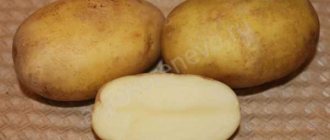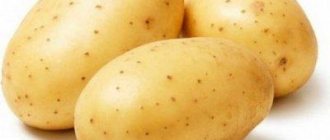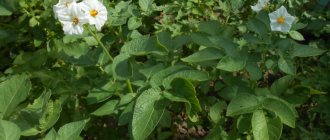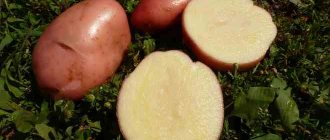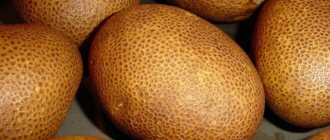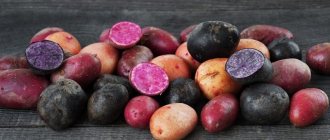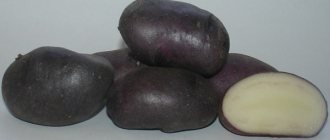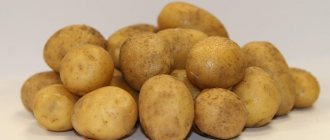FOR COMMUNAL RESIDENTS
For summer residents - useful tips for gardeners and vegetable gardeners
Popular
GROWING ARTICHOKE FROM SEEDS
Home › Vegetable garden › Vegetables › Potatoes
Views: 2,391
Potatoes are considered a perennial crop, but in reality the tubers are planted and harvested every season as an annual plant. To get a good harvest of this crop, you need to choose the right potato variety. In this article we will look at the best and most popular potato varieties in alphabetical order.
Inexperienced amateurs believe that no special skills are needed to get a good harvest. Of course, potatoes do not need greenhouses or expensive fertilizers, but several important points must be observed. This plant does not tolerate drought and does not tolerate stagnant water.
The plant needs abundant moisture, but without stagnation, which can be difficult to achieve in average regions located north of the central ones. Any novice gardener can find a lot of useful information about the rules of growing potatoes.
Classification of early varieties
Scientists have created over 4,000 varieties that differ in a number of characteristics, including the ripening period of tubers or the required number of days from crop germination to harvesting.
Early varieties include 3 varieties whose growing season does not exceed 80 days. They are suitable for cultivation in the southern regions, forming a harvest before the onset of the hot period.
According to the time of ripening, early potatoes are divided into:
- ultra-early - 35-50 days pass from germination to harvesting;
- early ripening - from 50 to 65 days;
- mid-early – 65-80 days.
There are other criteria for classification, for example, the purpose of cultivation. According to this criterion, potatoes are divided into:
- dining room;
- technical;
- stern;
- universal.
Seed potatoes: how to choose
Since potatoes are propagated mainly by tubers, the main share of success depends on the quality of planting material.
Why shouldn't you use your own potato planting material?
Potatoes, like no other crop, are easily affected by diseases: viral, bacterial, fungal and other infections penetrate through the leaves and accumulate in the tubers. In addition, varieties tend to degenerate. Therefore, you should not constantly use your own planting material - this will affect the harvest. Once every 3-4 years it needs to be updated by purchasing elite planting material grown in a specialized farm. The process of obtaining the “elite” is long and expensive; it begins with growing healthy plants in vitro and takes five years.
What size should tubers be for planting?
When choosing planting material, pay attention not only to taste, color, yield, but also to where the varieties are zoned, as well as to the ripening periods: early, middle, late. The characteristics of the variety are also important, for example, resistance to diseases, nematodes, etc.
It is better to choose large potato tubers (50–100 g) for sowing; only from them can strong plants grow that can produce a large harvest.
It is possible that some sellers may offer ordinary potatoes under the guise of “elite”, so when purchasing elite seeds, ask for a quality certificate.
The best ultra-early varieties
These ultra-early potato varieties differ from others in having the shortest growing season. They are resistant to diseases and are able to grow marketable tubers in 1.5 months. They are planted at the junction of April-May, waiting until the soil at a depth of 10 cm warms up to +10 degrees. To store it, you will need to wait until the outer shell of the tubers is fully formed and thicker.
Potato tubers contain many useful substances, are marketable and very tasty when boiled. The following potatoes from the ultra-early group received the greatest interest from farmers.
- Timo. A table plant that forms tubers in 45 days. Suitable for cultivation in any area of the country. Endowed with increased resistance to cancer and other insidious cultural diseases. It is realistic to get 35-60 tons from each hectare. The tubers are small, round, with a light shell and creamy flesh. After storage, potatoes retain their commercial properties for a long time.
- Riviera. This is perhaps the earliest variety; it is dug up 35 days after germination. Obtained in Holland, has good disease resistance. Productivity reaches 400 c/ha; there can be up to 12 potato tubers under a bush. In years with long summers, in the South, they manage to grow 2 crops. The plant is rapidly increasing its vegetative mass. Potatoes are endowed with excellent taste, oval in appearance, and of considerable size. The skin is yellow, not smooth. The pulp is light yellow.
- Lapis lazuli. Super early potatoes from Belarusian breeders, excellent resistance to nematodes. From 1 hectare it is possible to collect up to 260 c. The shell is yellow, the internal contents are white. Tubers contain 13-16% starch. Full ripening of the tubers occurs after 55 days, but harvesting begins after 1.5 months.
- Ariel. It is classified as a table plant and has good resistance to nematodes and late blight. Potatoes are dug up after 55-70 days. Capable of increasing 2 harvests during the warm season of the year. The skin of the tubers is light yellow and the inside is creamy. Potatoes are oval and can be stored for a long time.
- Vineta. Developed by German scientists. It is the best among early ripening varieties, with a strong immune system that allows it to resist common diseases. During the summer season it produces up to 40 t/ha. The bushes are straight, low, spreading. The bush grows up to 15 tubers. Potatoes are oval, small in size. The shell is yellow, the inside is of a delicate consistency, light brown. Harvesting begins on day 55.
- Impala. They are classified as super-early, the first potatoes begin to be dug up after 1.5 months. Designed for cooking. Feels good in the southern regions, tolerates heat and moisture deficiency. From 1 hectare they get 17-35 tons. Potatoes are oval, elongated, reaching 150 g. The fruit shell and internal contents are yellow. Moderately resistant to viruses, weakly resistant to other ailments.
How to properly care for the variety
Like any vegetable, Lel potatoes require care, albeit minimal. Care involves watering, fertilizing, hilling and weeding.
Features of watering
The variety loves a sufficient amount of moisture. In particularly dry areas, watering can be carried out up to 3 times a week.
If high air temperatures are expected in the summer, in order to avoid the risk of damage to the crop, it should be hilled up and watered abundantly. If the amount of precipitation in summer is moderate, then abundant watering is carried out 3 times:
- before flowering;
- after flowering;
- 2.5 weeks after the second watering.
Feeding and fertilizing
Lel potatoes need fertilizing. Fertilizer is applied three times during the growing season and includes urea, potassium and phosphorus.
For 1 sq. m. area, it is recommended to use urea - 2 tsp, potassium - 2 tsp, phosphorus - 4 tsp.
Hilling and weeding
Regular weeding is an integral process of caring for potatoes.
Absolutely any variety needs hilling and weeding. Removing weeds preserves the integrity of the tubers. If you neglect this procedure, the potatoes will develop worse due to the fact that the weeds will absorb moisture and nutrients from the soil.
Important! Loosening is carried out simultaneously with weeding in order to find and destroy the roots of weeds.
Lel spuds 2 times. The first time hilling occurs immediately after planting, and the second time after the potatoes have flowered. The comb must be at least 20 cm.
Hilled potatoes
The best early ripening varieties
Potato plots planted with varieties from the early-ripening group are harvested after 1.5 months. The most popular from this list is Zhukovsky early, with its large, attractive tubers.
These early-ripening potato varieties contain little starch, which is why they remain firm after cooking. Planting usually begins in early May. During the warm summer season you can grow 2 crops.
Important! The main advantage of early ripening varieties is that they are rarely affected by fungal diseases.
Below is a brief description of the most popular varieties of the early ripening group.
- Zhukovsky early. Plantations of this early-ripening potato can easily be found in Siberia, in the North-West of the country. Developed by our scientists, it ripens in 60 days, increasing the yield to 60 t/ha. The potatoes are pink, the inside is white. The oval-shaped tubers reach 150 g and contain 15% starch. Cancer-resistant, has good resistance to nematodes, and is endowed with strong immunity.
- Izora. Potatoes with excellent consumer reviews, table potatoes, quite productive. The tubers have time to ripen in 2 months. The bushes are medium-sized, with slightly dissected leaves. The flowers are painted white. The stems are thickened. The fruits are round and whitish. The interior is white, contains 10-12% starch. Potatoes can be stored for a long time. It resists cancer well, but often suffers from late blight.
- Antonina. Russian variety, common in Western Siberia, table variety. The weight of the potatoes is close to 150 g, the shape is oval with yellow internal contents and shell. Productivity – 210-425 c/ha. 6-10 fruits are dug from the bush, which contain 16-19.5% starch. It has good keeping quality.
- Sturdy. The bushes are low, semi-spreading. The leaves are colored in light green tones, small in size, moderately dissected. Smooth tubers grow under the bush, weighing up to 130 g, with a beige shell and creamy contents. In a normal season, up to 27.5 t/ha of tubers with 11% starch content are dug up. Usually 7 potatoes are dug from a bush. The variety is easy.
- Anosta. Table potatoes originated in the Netherlands. The bush reaches small sizes and is well leafed. The stems are green. The tubers are yellow, oval, the inside is also painted yellow. The eyes are small and shallow. The weight of the fruit can reach 70-134 g, starch content - 12-15%. Anosta potatoes are not resistant to late blight and are not affected by cancer.
- Arrow. A table variety that produces high yields and attractive tubers that don’t get overcooked. Potatoes are oval, above average size, covered with a yellow shell, the inside is white. Arrow potatoes are able to resist late blight, scab, and nematodes.
- Kholmogorsky. An early-ripening hybrid form for table use. The flowers are lilac and the tubers are red. Potatoes weigh 120 g, oval in shape, with a smooth shell and yellow interior. It does not darken during cooking. Medium-yielding, up to 390 centners are collected from 1 hectare. Kholmogory potatoes are not affected by viral pathogens or cancer.
Diseases and pests, how to fight
Potentially dangerous pests for the Lel potato variety are: the Colorado potato beetle and mole cricket. The variety is prone to diseases such as scab and late blight.
A solution containing tar is used against the Colorado potato beetle. The bush is treated with this solution only after flowering has ended.
A soap solution poured directly into the burrows where the insect lives works well against mole crickets. For preventive purposes, it is recommended to treat the potato field with an infusion of onion peels.
Treatment and prevention of late blight and scab involves treating the area with a solution of copper sulfate. You can also use various chemicals that are sold in specialized stores.
The central and southern regions of Russia are well suited for growing Belarusian potatoes of the Lel variety. It is a worthy competitor to other varieties of the popular vegetable. Due to the excellent taste and versatility of the fruit, they can be used in various dishes.
The best mid-early varieties
Mid-early potato varieties are able to reach maturity on the 70th day from the moment of emergence. The tubers are eaten and used to feed livestock. Varieties belonging to this group are resistant to the main potato diseases, with the exception of late blight. These potatoes are also distinguished by their excellent presentation and excellent taste.
This is interesting! 2 weeks before the planned digging of the crop, you need to mow the tops, which will have a beneficial effect on the storage time of the tubers.
Below are the best varieties from the mid-early group.
- Gala. A table variety, obtained in Germany and widely cultivated throughout our country. The tuber yield is 25 t/ha; under ideal conditions, 42 t/ha is obtained. The bushes are small, but the same cannot be said about the leaves. Flowers in white tones. The fruits are round, weigh 80-130 g, the shell and pulp are yellow. Starch content: 11-13%. The tubers are easy to transport and store.
- Red scarlet. Red Scardet table potatoes from Dutch breeders have gained considerable popularity among farmers for their high yield and beautiful red color of the tubers. Potatoes are oblong with cream-colored contents. A cancer-resistant plant that grows well in dry areas.
- Detskoselsky. Quite productive. The bush is small, but there are a lot of leaves. The flowers are painted white. Potatoes are small, can reach 120 g. The fruits contain 12-18% starch, they are covered with pink skin, the inside is white. Potatoes are flat oval. Differs in cancer resistance.
- Amorosa. Belongs to table varieties. Gardeners are captivated by its delicious taste and excellent commercial properties. Potatoes are oval, large, with a reddish shell and white internal contents.
- Marfona. It pleases farmers with its pretty yellow tubers, oval in shape. The inner pulp is yellow and not boilable. Potatoes are endowed with increased shelf life and can be stored until spring. The plant can withstand drought and excessive heat.
- Romano. Produced by Dutch specialists. The bushes are large, heavily leafy, the flowers are painted in purple and red tones. The plant produces pink fruits with oval-shaped creamy contents, weighing 180 g. Starch contains 11-14%. The plant is cancer-resistant. Tubers are harvested 80 days after emergence.
- Adretta. This is the result of the work of German specialists. Table potatoes reach productivity of 45 t/ha. The bush is low, blooms profusely, the corollas are painted white. Yellow, oval-shaped fruits reach 140 g, they contain 16% starch. One of the best varieties of mid-season potatoes.
Advantages and disadvantages
Pros:
- the tubers do not darken for a long time after cleaning;
- strong complex immunity to common pathogens;
- significant productivity;
- possibility of cultivation on different types of soil;
- requires little fertilizer and nutritional supplements;
- transported without damage;
- long-term preservation (until spring planting);
- stress resistance;
- tolerance to drought and temperature changes.
Minuses:
- watering is necessary in dry summers;
- there are a number of nuances during disembarkation that should be followed;
- preventive measures against the Colorado potato beetle.
A selection of popular early varieties
In addition to the above varieties, they have gained great interest among vegetable growers.
- Bellarosa. One of the worthy varieties for areas with arid climates, grows on any soil. The bushes reach great heights. The potatoes are round, pink in color, and the inside is yellow. From 1 hectare they get 32 tons or more. Resists viruses well.
- Luck. Early potatoes, with small bushes, attract vegetable growers because they produce only marketable potatoes. High-yielding, 43 tons are obtained from 1 hectare. Under the bush, 11-15 potatoes are formed and the weight of each of them is 110-150 g.
- Visa. Suitable for cultivation in northern areas and yields 500 c/ha. Potatoes are oval-round with a reddish shell. During long-term storage, 89% of potatoes retain their properties.
- Odysseus. It is readily planted by farmers in the Black Earth belt. The weight of the potatoes is 95-110 g, they are colored yellow, and the internal contents are also yellow. The maximum yield is 300 c/ha.
- White Night. Used for food purposes, ripens in 75 days. The bush is small in size with a straight stem, the leaves are dissected, and the corollas are painted white. The potatoes are white, round, and the inside is creamy. Weight is 130-210 g.
- Nevsky. Russian high-yielding potatoes. 1.5 kg of tubers are dug out from the bush. The height of the bushes is small, they are quite leafy, and the flowers are white. The fruits are oval, weigh up to 125 g, light yellow, creamy inside.
- Rocco. Produces red oval fruits with a creamy interior. Leading workers collect almost 40 tons from 1 hectare. Flowering is weak or non-existent. Rare flowers are painted in reddish and purple tones. A plant with a short ripening period.
Real, Belarusian potatoes “Lileya”: description of the variety and care tactics
Belarusian potatoes are not just a vegetable, but a real brand known all over the world. Perhaps this is why the Lileya variety has so many fans.
This is an ideal example of a classic bulba - large, productive, elegant and very tasty. The variety has been tested by farmers and gardeners; it is resistant to diseases and very productive.
In this article we will look at Lileya potatoes from all sides - a description of the variety, photos, main characteristics and recommendations for growing will help you get an excellent harvest.
…
| Variety name | Lily |
| general characteristics | A productive variety of Belarusian selection |
| Maturation period | 65-70 days |
| Starch content | 11-18% |
| Weight of marketable tubers | 100-200 gr |
| Number of tubers in a bush | 8-15 |
| Productivity | up to 670 c/ha |
| Consumer qualities | good taste and low overcooking |
| Keeping quality | 90% |
| Peel color | yellow |
| Flesh color | yellow |
| Preferred Growing Regions | Northwestern, Central, Volgo-Vyatka |
| Disease resistance | highly resistant to tuber blight, potato cancer and nematode |
| Features of cultivation | responds well to additional fertilizers |
| Originator | RUE "Institute of Potato Growing of the National Academy of Sciences of Belarus" |
Main characteristics of the variety:
- large tubers, weighing from 100 to 200 g;
- round-oval shape;
- tubers are neat, balanced in weight and size;
- defects are minimal, there are no bumps or potholes on the root crops;
- the peel is yellow, evenly colored, moderately smooth;
- the eyes are superficial, shallow, of medium size;
- the pulp is light yellow when cut;
- starch content ranges from 11.4 to 17.5%;
- tubers are rich in protein, valuable amino acids, and carotene.
Photo of Lileya potato variety:
Description of the plant
The Lileya potato variety belongs to the mid-early table variety. The yield is very good; depending on climatic conditions and the nutritional value of the soil, from 246 to 400 centners of selected potatoes can be harvested from 1 hectare.
The maximum yield was recorded at 760 centners per hectare. Harvested potatoes are well stored, keeping quality is 90%. Transportation possible.
Read more about storage times and temperatures, and about possible problems. And also about how to properly store root vegetables in winter, on the balcony, in boxes, in the refrigerator, peeled.
The yield of other potato varieties is presented in the table below:
The bush is medium-sized, erect, intermediate type, moderately spreading. The formation of green mass is abundant. The leaves are dark green, medium-sized, of intermediate type, with slightly wavy edges. The corolla is compact, made up of large white flowers. The root system is well developed, up to 15 potatoes are formed under each bush.
The tubers set quickly and ripen together. The first potatoes can be dug up already in the middle of summer, but the bushes reach their maximum yield by the end of the growing season.
Potatoes are undemanding to care, and agricultural technology is simple. Prefers light, nutritious soils; in poor soil, the yield is significantly reduced. During the planting season, you need to feed it 2-3 times with mineral complexes or organic matter. Read more about when and how to apply fertilizers, and how to do it when planting.
Drip irrigation is also recommended. The bushes are hilled at least 2 times, forming high ridges. Read about how to grow potatoes without weeding and hilling here.
The tubers are resistant to mechanical damage, which greatly facilitates harvesting and reduces the amount of waste. Mulching will help prevent weeds.
The variety is resistant to many typical nightshade diseases: potato blight, golden cyst nematode, and common scab. Rarely affected by viruses. Moderately susceptible to late blight of tubers and leaves.
The best varieties for different geographical locations
The same variety in different areas may not feel the same. This is as it should be, since experts create them for specific regions. Zoned varieties are better adapted to the local climate, suffer less disease and show excellent productivity.
The following are varieties suitable for cultivation in specific areas.
- Middle lane. Common in this area:
- Ural early;
- Friendly;
- Slav;
- Vyatka.
- Moscow region and surrounding areas. Popular here:
- Spring;
- Nevsky;
- Lugovskoy;
- Timo.
- Leningrad region and nearby places. Varieties adapted to cold climates are used for planting:
- Aurora;
- Fresco;
- Latona;
- Christmas;
- Sante.
After reading this article, it becomes clear that there are many early ripening varieties.
How to choose the right potato variety so that it grows well in your region and produces a lot of produce?
Experienced gardeners recommend planting several varieties that ripen at different times. And in the fall, after digging up the potatoes, see which one is more suitable. We recommend testing regionalized varieties first, as they are more adapted to your region.
Landing
Before planting, seed tubers are soaked in a stimulant (Epine, Bioglobin, Protein). Copper preparations and contact fungicides are used for disinfection. To protect potatoes from larvae of pests and beetles, they are sprayed with insecticides - Komandor, Aktara, Benzophosphate, Tanrek.
For planting, material measuring 4 by 6 cm is suitable. Average weight is 40-60 g. Large tubers are cut so that at least 3 eyes remain on the slices. Germination lasts 2-3 weeks. During this time, the seedlings grow up to 1.5 cm.

